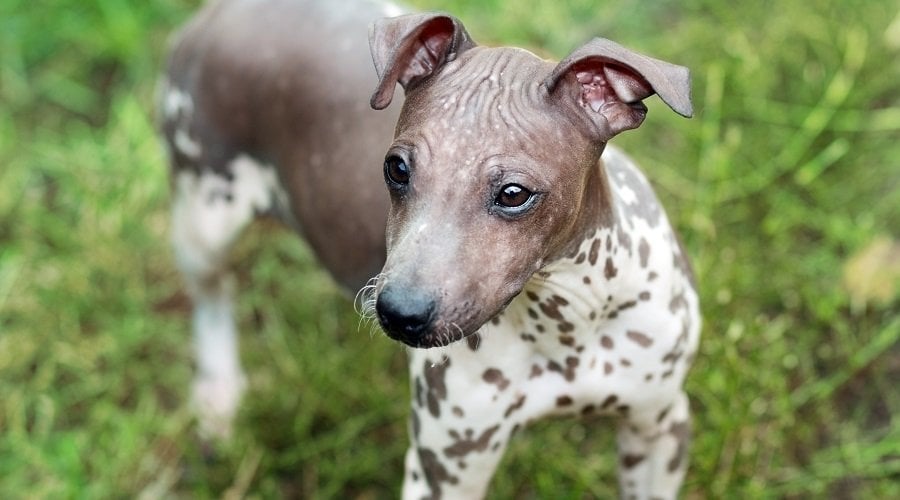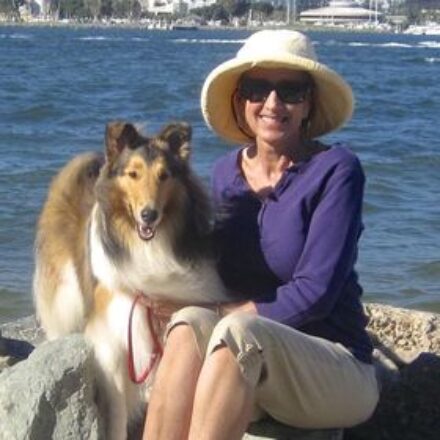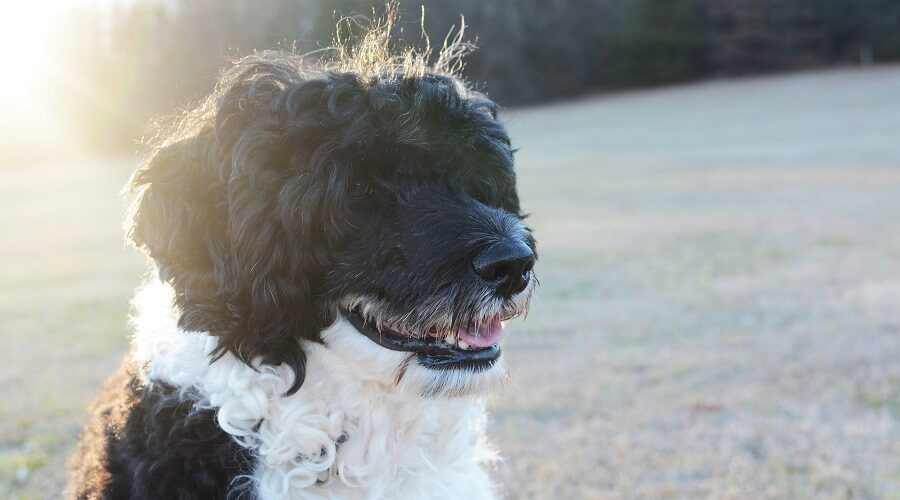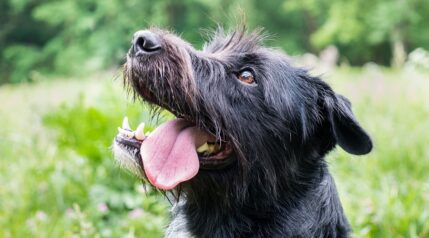So, you’ve always dreamed of owning a dog, but you suffer an allergy attack whenever you come into contact with one. Curious what the best hypoallergenic dog breeds are? Well, you’re not alone! According to statistics produced by the American College of Allergy, Asthma, and Immunology, almost ten percent of the U.S. population has an allergy to dogs, and many of these people want to own a pup!
If you are one of the unlucky ten percent with a dog allergy, don’t despair. You may still be able to own a dog, without suffering unpleasant side effects! In this article, we find out what causes pet allergies and discuss what you can do to prevent a pooch’s presence from triggering an adverse reaction.
Also, we expose the myth of the 100 percent hypoallergenic pup, and take a look at our 20 favorite breeds that have low shedding and pet dander. As an allergy sufferer, this should give you some insight into a canine companion that won’t completely trigger an allergic reaction.
What Are Dog Allergies?
First of all, let’s talk about what’s causing your allergy and what symptoms you may be suffering. While this list is not all-inclusive, it’s a good starting point for what you may be feeling if you have an allergic reaction to dogs. Pet allergies cause a few well-recognized symptoms, including:
- A runny nose
- Watering eyes
- Sneezing
- Asthma
- Tight, closed feeling in your chest
- Wheezing
You may suffer any or all of these effects whether a dog is present or not. Allergy sufferers are often affected just by entering a room where a dog has been or by spending time around canine owners who have been in close contact with their pets. So, how come? Well, pet allergies are caused by pet dander that remains in the environment, even when the animal has gone.
Pet Dander
Pet dander is a substance that’s made up of tiny flecks of skin that are shed by any creature that has fur or feathers. These microscopic fragments of skin can cause allergic reactions in people who are vulnerable to these specific triggers. Dogs that shed their coat excessively or frequently are prime causes of allergies. That’s because each hair that’s shed carries with it a tiny fragment of skin.
In addition to pet dander, your pet’s saliva, feces, and urine can also cause an allergic reaction in those who are susceptible. Where dogs are concerned, it’s the Can f II protein in your furry friend’s saliva that causes the problem. Dried saliva that’s loaded with allergens flakes away from the dog’s fur after he’s licked himself and becomes airborne. You inhale this protein-loaded dusty substance as it floats unseen around your home, and the allergic symptoms begin.
In the same way, dust from dried dog feces can enter the air, and the unsuspecting allergy sufferer breathes it in. Even if you take your pup outside for a walk or to the dog park for a bathroom break, tiny drops of urine stuck to the dog’s fur can be brought back into your home. When the urine dries, tiny flakes enter the atmosphere and are inhaled, triggering your allergy.
How Dander Spreads
The fragments of dander have rough, ragged edges and are also incredibly lightweight. That means that the dander floats in the air and sticks to every surface it touches such as your clothes, carpets, drapes, and furniture.
So, every time you walk around your home, you will disturb the dust in your carpets. The dander-laden dust then floats up into the air, sticks to your clothes, and hitches a ride with you wherever you go. So, you could unwittingly transfer pet dander into an environment that’s never even seen a dog such as your local mall, your office, your medical center, or even on an airplane. You get the picture.
What Happens Next
After you’ve inhaled these minute particles of urine, saliva, feces, or skin, your immune system goes into overdrive, thinking germs are attacking it. In people with allergies, their immune system assumes that these harmless doggy proteins are dangerous invaders and creates an antibody to deal with them.
Each time your body encounters the trigger proteins, the antibodies stimulate mast cells. The mast cells release chemicals called histamines, which attack the invading proteins, and in doing so, cause the allergy symptoms mentioned above.
As long as you’re exposed to the trigger proteins, the allergic reaction continues. That’s when a canine allergy can get dangerous, as prolonged allergy attacks can lead to severe secondary complications such as sinusitis, bronchitis, and asthma.
Getting Rid of Dander
So, how do you get rid of dog dander? There are several ways of reducing the amount of allergy-causing dog dander in your home. Let’s look at a few ways to reduce allergens, and some all-around good habits you should have if pet dander is a problem for your household.
- Groom your pup daily to reduce the amount of dander that’s produced.
- Always groom your pet outside your home to keep the dander from flying up into your face.
- Don’t bathe your dog too often – it can be bad for your pup’s skin.
- Instead, use pet wipes as an alternative, and you should use a de-shedding tool daily or weekly.
- Vacuum your home daily if possible. It’s good to use a HEPA filtered vacuum cleaner.
- Avoid using a bagless vacuum cleaner, as emptying the dust container will expose you to allergens.
- If you have a cylinder vacuum cleaner, put on a dust mask before you empty the bin of debris.
- Always vacuum all areas of your home, including walls, rugs, furniture, draperies, blinds, and carpets.
- Use a HEPA air filter in your home.
- Use anti-allergen sprays around all areas in your home to which your dog has access.
- Choose an anti-allergen spray that’s tannic-based or pick products that use alkaline substances.
- Restrict your pup’s access to particular areas of your home.
- Especially, keep Fido off your bed and out of your bedroom.
- Ideally, your bedroom should be a dander-free zone.
- Wash your dog’s toys and bedding frequently to get rid of dried saliva, urine, and feces.
Another way of controlling your dog allergy is to have regular immunotherapy or allergy shots. Immunotherapy works by gradually increasing the dose of an allergen that you receive. Over time, that builds your tolerance to the allergen, reducing or eliminating your symptoms. To find out more about immunotherapy, have a chat with your family doctor.
Hypoallergenic Dog Myths
You may have heard that certain breeds of dogs are hypoallergenic. Hypoallergenic dogs are said not to cause allergic reactions, but is that really true? Well, according to a study carried out in 2011, dust samples from homes with reportedly hypoallergenic breeds of dogs were tested, along with samples taken from homes with other breeds.
All the samples were found to contain the same levels of dust and dander. Therefore, it’s true to say that the 100 percent hypoallergenic dog is really just an urban myth and not even an interesting fact.
That said, there are a large number of dogs that are minimal shedders. In theory, minimal shedding means less dander. So, if you opt for one of these breeds and take note of our dander control suggestions above, you could still own a dog and not suffer for it!
20 Low Shedding Breeds
Here’s our top 20 breeds that could be suitable for you if you have a dog allergy. Keep in mind as we’ve said, that not all breeds are hypoallergenic. This is a good list that you can test and trial if you have pet allergies to see if one of these hypoallergenic dog breeds may be compatible with your allergies. We always recommend a test run at a breeder or rescue before you bring one home.
Maltese

The Maltese is famous for his show-stopping, floor-length, flowing white coat. Maltese are members of the toy breed group, only weighing up to seven pounds. If you opt for a Maltese, you’ll find them playful, charming, lovable little dogs that won’t shed much. This breed is also crossed over with other hypoallergenic dogs, like the poodle to create the maltipoo.
Tibetan Terrier

Tibetan terriers are small, bushy coated dogs that shed minimally. However, you’ll still need to groom your dog frequently to keep their coat in good condition. Also known as the “Holy Dog of Tibet,” the Tibetan terrier was initially used as a watchdog and companion in Buddhist monasteries. Tibetan terriers are known to be intelligent, sensitive, and loving.
Brussels Griffon

If you live in a small apartment and you don’t have kids, the Brussels griffon could make a perfect pocket-sized pet that hardly sheds at all. The toy Brussels griffon is a friendly breed that’s fiercely loyal to one person. They are very unique pups, and are sure to draw a crowd no matter where you go. They are relatively rare in the US when compared to other dog breeds.
Shih Tzu

The Shih Tzu is another member of the toy group. These little dogs are friendly and loyal, and they are also minimal shedders. In fact, the “Lion Dog’s” coat only falls out when it’s brushed or broken. If you choose a Shih Tzu, you’ll be joining a long line of owners that goes back over 1,000 years! The Shih Tzu is a very popular dog to cross with other breeds, creating other interesting low shedders, like the Shichi.
Portuguese Water Dog

If you’d prefer a larger canine companion, you might like to consider the Portuguese water dog. Athletic, affectionate, and adventurous, the Portuguese water dog is a member of the working group. These pups have a short, curly coat that sheds minimally. A large Portuguese water dog can grow to weigh around 50 pounds, measuring up to 23 inches at the shoulder, so you’ll need a spacious home and garden if you want to own one of these pups.
Poodle

Poodles come in several sizes; toy, miniature, and standard. Poodles are proud, highly intelligent, active, and easy to train. Also, they have short, curly coats that barely shed at all. Because of this, poodles are often used in crossbreeds of other purebred dogs. This includes pups like the cavalier king charles spaniel & poodle, as well as the Bernedoodle.
West Highland Terrier

The Westie is another breed that barely sheds, making them a suitable choice for dog allergy sufferers.Westies are friendly, active little dogs that are unstintingly loyal and make excellent watchdogs. The Westie may be small, but the breed has been around for over 300 years and is the most popular of the small terrier group.
Kerry Blue Terrier

The Kerry blue terrier is also known as the Irish blue. These intelligent, alert dogs were used as working dogs for such duties as guarding livestock, hunting pests, and herding. Kerry blues have a very fine, curly coat that’s similar in texture to human hair and does not shed. The Kerry blue is one of the largest of the terrier group and is popular for his companionship and watchdog qualities.
Chinese Crested

The Chinese crested is a very unusual breed with a strange, bald-skinned look that’s not going to appeal to everyone. There are two varieties of Chinese crested; the hairless and the powderpuff. Both types shed very little and are considered suitable for dog allergy sufferers. The tiny Chinese crested originates from Africa. However, Chinese traders used the dogs on board their ships to control vermin, and the breed was therefore renamed the Chinese crested.
Scottish Terrier

The Scottish terrier, or Scottie, makes a very loyal companion. These short, stocky members of the terrier group are high-spirited and confident. Some owners say that their Scotties are almost human! Also, the breed has a short, wiry coat that doesn’t shed much. This breed is a great breed for those that have allergies and need a hypoallergenic breed companion.
Cairn Terrier

Hailing from Scotland, the Cairn Terrier is another member of the terrier group. The breed’s name derives from the large stone piles (cairns) in which the dogs were used for hunting vermin. The Cairn’s short, wiry coat is water-repellent and known for its low shedding and colorful coats. Happy, curious, and bright, your Cairn will enjoy having somewhere he can dig and explore, so keen gardeners beware!
Irish Water Spaniel

The Irish water spaniel is a member of the sporting group and has been around for several centuries. If you’re looking for a larger dog, these guys can weigh about 58 pounds and measure up to 24 inches at the shoulder. The Irish water spaniel was originally used as a companion and hunting dog, being active, friendly, and devoted to his owners. Although you’ll need to groom your dog regularly to keep his coat in good condition, the breed doesn’t shed much and is thus considered suitable for those with pet allergies.
Labradoodle

The Labradoodle is a relatively modern designer breed that’s a cross between a Labrador retriever and a miniature or standard poodle. Although each dog’s temperament is inherited in part from each of his parents, well-bred Labradoodles are generally friendly, good-natured types that are low shedders. Mini labradoodles are also popular, and often a great option for those looking at a hypoallergenic dog breed. There’s also the Australian version of the labradoodle as well.
Border Terrier

The Border terrier is a brave, affectionate breed that was bred to hunt rodents and foxes. Recognized by fanciers as a rugged, sturdy terrier, the Border has a wiry coat that sheds very little and gets by with a brief weekly brushing. Although these little dogs are perfect for people with pet allergies, you might want to steer clear of them if you have small pets such as rabbits or rats, as the Border’s hunting instinct is still very strong!
Schnauzer

The popular Schnauzer comes in three sizes, miniature, standard, and giant. All versions of the breed have a low-shedding coat and would make a suitable companion for someone with a dog allergy. The German Schnauzer breed was used originally as guard dogs, watchdogs, and for catching vermin. The Schnauzer is a high-energy, companionable breed that would suit an active, outdoorsy family.
Yorkshire Terrier

The cute but spunky Yorkie shouldn’t be underestimated! The breed was originally bred to catch rats in the mines and mills of Yorkshire, England. Later, the glorious, glossy, floor-sweeping coat of the Yorkie caught the eye of Victorian ladies who quickly adopted the breed as a pampered lapdog. Despite the Yorkie’s luxuriant coat, the breed is a light-shedder that would be suitable for a dog lover with a pet allergy and they also live quite a while. They also come in smaller sizes.
Australian Silky Terrier

The Australian silky terrier is a close relative of the Yorkshire terrier. It’s thought that the Aussie terrier resulted from cross-breeding various terrier type dogs that were brought to Australia by early colonists. Fearless and tough, Aussies were used as all-purpose exterminators, tackling small mammals and even snakes! The breed is brave and bold but equally devoted and enjoys nothing more than a cuddle with their owner. Also, the Aussie’s silky coat hardly sheds, which is good news for dog allergy sufferers.
Bouvier Des Flandres

The Bouvier des Flandres is named for their original occupation as the “cow herder of Flandres.” The barrel-chested, burly breed was used for herding and as a watchdog. Modern Bouvier des Flandres have seen service as police dogs and guard dogs. But these low-shedding dogs are also known to be gentle, loyal, companions.
Basenji

The Basenji originates from Central Africa where the breed was used as a hunting dog. Typically independent and somewhat challenging to train, the Basenji is also intelligent and friendly. The breed’s coat is short and takes little grooming to keep it looking good. Also, the Basenji is a very light shedder. A Basenji is one of few breeds that don’t bark. Instead, these pups howl, which could be something to bear in mind if you have near neighbors who want a peaceful life!
American Hairless Terrier

The American hairless terrier is a native of Louisiana, and he’s the perfect choice for those with a dog allergy who want a pet. You’ll find the breed to be smart, curious, and very playful with a coat that barely sheds. The American hairless terrier is a naturally occurring variety of the Rat terrier. Obviously this dog doesn’t have hair, making it a popular pick for people with allergies.
Final Thoughts
Just because you have a dog allergy, that doesn’t mean that you have to miss out on the joys of dog ownership! As you’ve seen from this article, there are at least 20 fabulous dog breeds of different sizes and personalities that you could consider, all of which shed their coats minimally, making them suitable for allergy sufferers.
However, it’s important to remember that dog allergy is typically caused by pet dander, rather than by dog hair. That means you’ll need to groom your pet daily, vacuum your home at least once a day, and use a HEPA filter to keep your home free from dander.
If you visit the homes of friends who have dogs, your allergy could still be triggered. Before you get your own dog, it’s sensible to speak to your family doctor for more advice on immunotherapy or other allergy treatment that might be suitable for you.






I wanted basenji BUT tHeRe aLL tHe wAy iN *
AFRICA*
This is the most elaborate list I have seen yet. But I would like to add that the Barzoi too deserves a spot on this list. I am 100% allergic to dogs but with regular vacuum cleaning and brushing (every two days or about) I am doing just fine.
Now I would like to add that the Borsoi is a very particular breed and definitely not for everyone: they shed all year round a little and twice a year massively, to keep their coat from matting brushing isn’t just for allergic people but very necessary, they need two hours of running (not walking on leash, free range running) a day.
They sleep about 20 hours a day and they are very intelligent on an emotional level so with a recall for example they will know what you ask (and ask it will be) and then do their thing for 20 seconds longer and then come as if of their own accord. That was just crash course on Barzois for ya, I don’t really know why but anyways.
Thanks for the Comment Debora! We will definitely add this breed to the next round when we update the article!